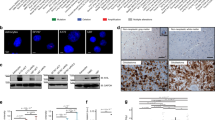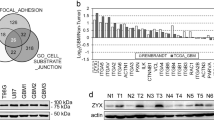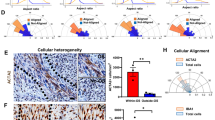Abstract
Malignant glioma invasion is a primary cause of brain cancer treatment failure, yet the molecular mechanisms underlying its regulation remain elusive. We developed a novel functional-screening strategy and identified downregulated in renal cell carcinoma (DRR) as a regulator of invasion. We show that DRR drives invasion in vitro and in vivo. We found that while DRR is not expressed in normal glial cells, it is highly expressed in the invasive component of gliomas. Exploring underlying mechanisms, we show that DRR associates with and organizes the actin and microtubular cytoskeletons and that these associations are essential for focal adhesion (FA) disassembly and cell invasion. These findings identify DRR as a new cytoskeletal crosslinker that regulates FA dynamics and cell movement.
This is a preview of subscription content, access via your institution
Access options
Subscribe to this journal
Receive 50 print issues and online access
$259.00 per year
only $5.18 per issue
Buy this article
- Purchase on Springer Link
- Instant access to full article PDF
Prices may be subject to local taxes which are calculated during checkout







Similar content being viewed by others
References
Beadle C, Assanah MC, Monzo P, Vallee R, Rosenfeld SS, Canoll P . (2008). The role of myosin II in glioma invasion of the brain. Mol Biol Cell 19: 3357–3368.
Burridge K, Chrzanowska-Wodnicka M . (1996). Focal adhesions, contractility, and signaling. Annu Rev Cell Dev Biol 12: 463–519.
Del Duca D, Werbowetski T, Del Maestro RF . (2004). Spheroid preparation from hanging drops: characterization of a model of brain tumor invasion. J Neurooncol 67: 295–303.
Dirks PB . (2008). Brain tumor stem cells: bringing order to the chaos of brain cancer. J Clin Oncol 26: 2916–2924.
Ezratty EJ, Partridge MA, Gundersen GG . (2005). Microtubule-induced focal adhesion disassembly is mediated by dynamin and focal adhesion kinase. Nat Cell Biol 7: 581–590.
Fernandez C, Figarella-Branger D, Girard N, Bouvier-Labit C, Gouvernet J, Paz Paredes A et al. (2003). Pilocytic astrocytomas in children: prognostic factors—a retrospective study of 80 cases. Neurosurgery 53: 544–553.
Friedl P, Wolf K . (2003). Tumour-cell invasion and migration: diversity and escape mechanisms. Nat Rev Cancer 3: 362–374.
Giese A, Loo MA, Tran N, Haskett D, Coons SW, Berens ME . (1996). Dichotomy of astrocytoma migration and proliferation. Int J Cancer 67: 275–282.
Johnston AL, Lun X, Rahn JJ, Liacini A, Wang L, Hamilton MG et al. (2007). The p75 neurotrophin receptor is a central regulator of glioma invasion. PLoS Biol 5: e212.
Kaverina I, Rottner K, Small JV . (1998). Targeting, capture, and stabilization of microtubules at early focal adhesions. J Cell Biol 142: 181–190.
Kaverina I, Krylyshkina O, Small JV . (1999). Microtubule targeting of substrate contacts promotes their relaxation and dissociation. J Cell Biol 146: 1033–1044.
Kleihues P, Cavenee WK . (2000). World Health Organization Classification of Tumours of the Nervous System. WHO/IARC: Lyon.
Krylyshkina O, Kaverina I, Kranewitter W, Steffen W, Alonso MC, Cross RA et al. (2002). Modulation of substrate adhesion dynamics via microtubule targeting requires kinesin-1. J Cell Biol 156: 349–359.
Krylyshkina O, Anderson KI, Kaverina I, Upmann I, Manstein DJ, Small JV et al. (2003). Nanometer targeting of microtubules to focal adhesions. J Cell Biol 161: 853–859.
Lauuffenburger DA, Horwitz AF . (1996). Cell migration: a physically integrated process. Cell 84: 359–369.
Louis DN, Pomeroy SL, Cairncross JG . (2002). Focus on central nervous system neoplasia. Cancer Cell 1: 125–128.
Palazzo AF, Gundersen GG . (2002). Microtubule-actin cross-talk at focal adhesions. Sci STKE 2002: PE31.
Pedersen PH, Edvardsen K, Garcia-Cabrera I, Mahesparan R, Thorsen J, Mathisen B et al. (1995). Migratory patterns of lac-z transfected human glioma cells in the rat brain. Int J Cancer 62: 767–771.
Ridley AJ, Schwartz MA, Burridge K, Firtel RA, Ginsberg MH, Borisy G et al. (2003). Cell migration: integrating signals from front to back. Science 302: 1704–1709.
Rodriguez OC, Schaefer AW, Mandato CA, Forscher P, Bement WM, Waterman-Storer CM . (2003). Conserved microtubule-actin interactions in cell movement and morphogenesis. Nat Cell Biol 7: 599–609.
Salhia B, Tran NL, Symons M, Winkles JA, Rutka JT, Berens ME . (2006). Molecular pathways triggering glioma cell invasion. Expert Rev Mol Diagn 6: 613–626.
van den Boom J, Wolter M, Blascke B, Knobbe CB, Reifenberger G . (2006). Identification of novel genes associated with astrocytoma progression using suppression subtractive hybridization and real-time reverse transcription-polymerase chain reaction. Int J Cancer 119: 2330–2338.
Verkhovsky AB, Svitkina TM, Borisy GG . (1995). Myosin II filament assemblies in the active lamella of fibroblasts: their morphogenesis and role in the formation of actin filament bundles. J Cell Biol 131: 989–1002.
Wang L, Darling J, Zhang JS, Liu W, Qian J, Bostwick D et al. (2000). Loss of expression of the DRR 1 gene at chromosomal segment 3p21.1 in renal cell carcinoma. Genes Chromosomes Cancer 27: 1–10.
Wang L, Rahn JJ, Lun X, Sun B, Kelly JJ, Weiss S et al. (2008). Gamma-secretase represents a therapeutic target for the treatment of invasive glioma mediated by the p75 neurotrophin receptor. PLoS Biol 6: e289.
Webb DJ, Donais K, Whitmore LA, Thomas SM, Turner CE, Parsons JT et al. (2004). FAK-Src signalling through paxillin, ERK and MLCK regulates adhesion disassembly. Nat Cell Biol 6: 154–161.
Wu X, Kodama A, Fuchs E . (2008). ACF7 regulates cytoskeletal-focal adhesion dynamics and migration and has ATPase activity. Cell 135: 137–148.
Yamana N, Arakawa Y, Nishino T, Kurokawa K, Tanji M, Itoh RE et al. (2006). The Rho-mDia1 pathway regulates cell polarity and focal adhesion turnover in migrating cells through mobilizing Apc and c-Src. Mol Cell Biol 26: 6844–6858.
Zijlstra A, Lewis J, Degryse B, Stuhlmann H, Quigley JP . (2008). The inhibition of tumor cell intravasation and subsequent metastasis via regulation of in vivo tumor cell motility by the tetraspanin CD151. Cancer Cell 13: 221–234.
Acknowledgements
We are grateful to Carmen Sabau for her technical expertise. This work was supported by Goals for Lily, the Alex Pavanel Family, the Franco Di Giovanni Funds for Brain Tumor Research, the Montreal English School Board, the B-Strong Foundation to RFDM, and the Montreal Neurological Institute to KP. RMWO was supported by the Canadian Institute of Health Research doctoral fellowship. AAL was supported by the National Cancer Institute of Canada Terry Fox Studentship.
Author information
Authors and Affiliations
Corresponding author
Ethics declarations
Competing interests
The authors declare no conflict of interest.
Additional information
Supplementary Information accompanies the paper on the Oncogene website
Supplementary information
Rights and permissions
About this article
Cite this article
Le, P., Angers-Loustau, A., de Oliveira, R. et al. DRR drives brain cancer invasion by regulating cytoskeletal-focal adhesion dynamics. Oncogene 29, 4636–4647 (2010). https://doi.org/10.1038/onc.2010.216
Received:
Revised:
Accepted:
Published:
Issue Date:
DOI: https://doi.org/10.1038/onc.2010.216
Keywords
This article is cited by
-
Nucleic acid drug vectors for diagnosis and treatment of brain diseases
Signal Transduction and Targeted Therapy (2023)
-
Transcriptomics profiling reveal the heterogeneity of white and brown adipocyte
Journal of Bioenergetics and Biomembranes (2023)
-
A bioprinted human-glioblastoma-on-a-chip for the identification of patient-specific responses to chemoradiotherapy
Nature Biomedical Engineering (2019)
-
Microglial activation in an amyotrophic lateral sclerosis-like model caused by Ranbp2 loss and nucleocytoplasmic transport impairment in retinal ganglion neurons
Cellular and Molecular Life Sciences (2019)
-
Expression and glucocorticoid-dependent regulation of the stress-inducible protein DRR1 in the mouse adult brain
Brain Structure and Function (2018)



